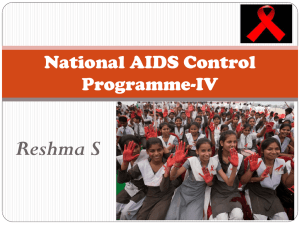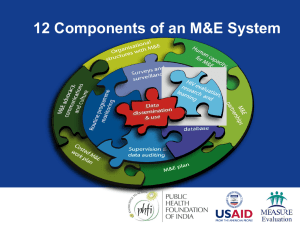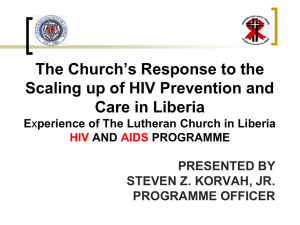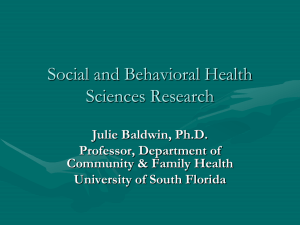Positive Health, Dignity, and Prevention Behavioral Interventions
advertisement
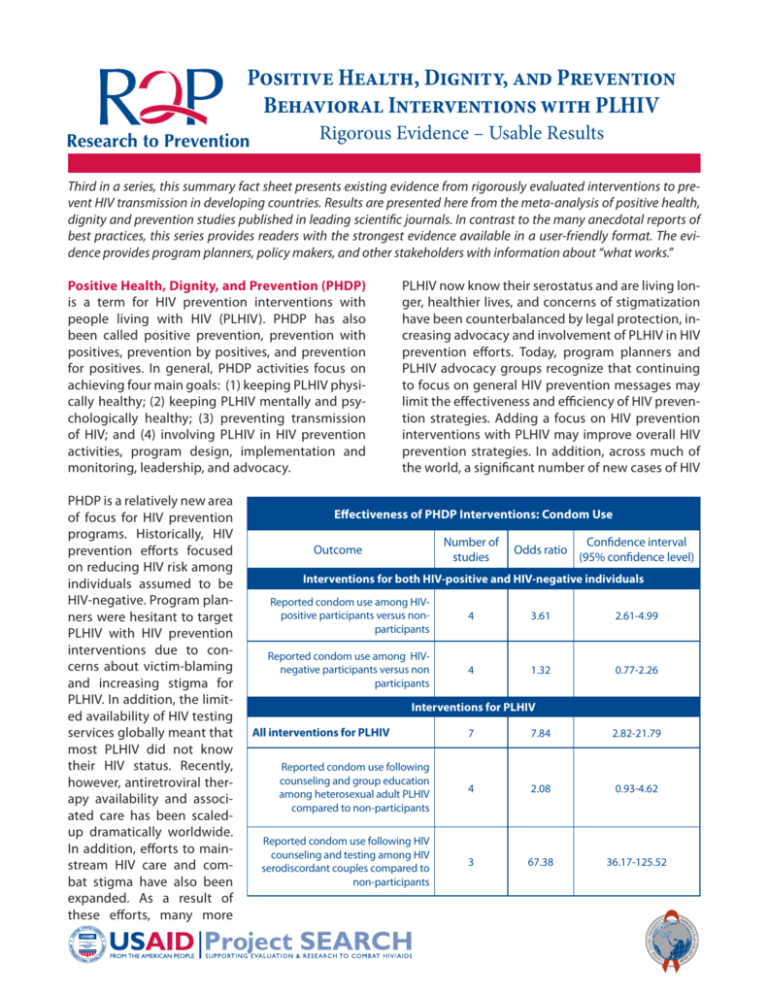
Positive Health, Dignity, and Prevention Behavioral Interventions with PLHIV Rigorous Evidence – Usable Results Third in a series, this summary fact sheet presents existing evidence from rigorously evaluated interventions to preDecember 2010 vent HIV transmission in developing countries. Results are presented here from the meta-analysis of positive health, dignity and prevention studies published in leading scientific journals. In contrast to the many anecdotal reports of best practices, this series provides readers with the strongest evidence available in a user-friendly format. The evidence provides program planners, policy makers, and other stakeholders with information about “what works.” Positive Health, Dignity, and Prevention (PHDP) is a term for HIV prevention interventions with people living with HIV (PLHIV). PHDP has also been called positive prevention, prevention with positives, prevention by positives, and prevention for positives. In general, PHDP activities focus on achieving four main goals: (1) keeping PLHIV physically healthy; (2) keeping PLHIV mentally and psychologically healthy; (3) preventing transmission of HIV; and (4) involving PLHIV in HIV prevention activities, program design, implementation and monitoring, leadership, and advocacy. PHDP is a relatively new area of focus for HIV prevention programs. Historically, HIV prevention efforts focused on reducing HIV risk among individuals assumed to be HIV-negative. Program planners were hesitant to target PLHIV with HIV prevention interventions due to concerns about victim-blaming and increasing stigma for PLHIV. In addition, the limited availability of HIV testing services globally meant that most PLHIV did not know their HIV status. Recently, however, antiretroviral therapy availability and associated care has been scaledup dramatically worldwide. In addition, efforts to mainstream HIV care and combat stigma have also been expanded. As a result of these efforts, many more PLHIV now know their serostatus and are living longer, healthier lives, and concerns of stigmatization have been counterbalanced by legal protection, increasing advocacy and involvement of PLHIV in HIV prevention efforts. Today, program planners and PLHIV advocacy groups recognize that continuing to focus on general HIV prevention messages may limit the effectiveness and efficiency of HIV prevention strategies. Adding a focus on HIV prevention interventions with PLHIV may improve overall HIV prevention strategies. In addition, across much of the world, a significant number of new cases of HIV Effectiveness of PHDP Interventions: Condom Use Number of studies Outcome Odds ratio Confidence interval (95% confidence level) Interventions for both HIV-positive and HIV-negative individuals Reported condom use among HIVpositive participants versus nonparticipants 4 3.61 2.61-4.99 Reported condom use among HIVnegative participants versus non participants 4 1.32 0.77-2.26 Interventions for PLHIV All interventions for PLHIV 7 7.84 2.82-21.79 Reported condom use following counseling and group education among heterosexual adult PLHIV compared to non-participants 4 2.08 0.93-4.62 Reported condom use following HIV counseling and testing among HIV serodiscordant couples compared to non-participants 3 67.38 36.17-125.52 infection occur in HIV serodiscordant couples, but rates of HIV serostatus disclosure and condom use in such couples remain low. Focusing attention on HIV serodiscordant couples may therefore be an effective way of reducing HIV transmission. PHDP is a broad term that can encompass biological, behavioral, and structural interventions. Here, we focus on behavioral interventions with PLHIV, such as counseling and testing or group education interventions. Three review articles have examined behavioral interventions with PLHIV predominantly in the United States.1,2,3 To our knowledge, there has been just one systematic review of behavioral interventions with PLHIV in developing country settings.4 Effectiveness of PHDP Interventions A recent meta-analysis by Kennedy et al.4 examined two approaches for implementing PHDP interventions: strategies that target both HIV-positive and HIV-negative individuals and ones that focus specifically on PLHIV. Therefore, the meta-analysis examined two separate questions: (1) Do behavioral interventions targeting both HIV-positive and HIVnegative individuals affect these two groups differently? (2) Do interventions that target PLHIV effectively reduce HIV risk behaviors? Results of the meta-analysis showed that PHDP interventions in developing countries had the following effects on participants compared to those not exposed to the intervention: Question 1: Interventions for both HIV-positive and HIV-negative individuals (4 studies, 6 subgroup results) These studies looked at the effect of counseling and testing behavioral interventions on participants who learned their HIV status as part of the intervention. Length of follow-up ranged from 2 weeks to 14 months after testing. • Among PLHIV, participants were more than 3 times as likely to use condoms as non-participants. • Among HIV-negative individuals, participation in the interventions did not affect condom use. Question 2: Interventions specifically for PLHIV (7 studies, 7 subgroup results) • Among heterosexual HIV positive adults, there was no difference in condom use following counseling and group education. • Among serodiscordant couples who received HIV counseling and testing, both in an individual and couples- based setting, participants were many times more likely to use condoms than non-participants. The large odds ratio depicted in the table on page 1 (OR=67.38) results from the dramatic increase in condom use reported among serodiscordant couples following HIV counseling and testing as compared to little or no increase reported among non-participants. How is the Effectiveness of a PHDP Intervention Determined? The findings presented in this fact sheet come from a recent review of 19 studies. Of the 19 studies, 15 were conducted in sub-Saharan Africa,1 in Asia (China), 1 in Latin America (Brazil), and 2 studies came from multiple sites (Kenya, Tanzania, and Trinidad; 2 studies from 1 article). Participants in these studies were mostly heterosexual adults (12 studies) and HIV serodiscordant couples (5 studies), although one study was conducted among pregnant women (1 study) and one was conducted among sex workers (1 study). Selection Criteria and Rigor Criteria of Studies Included in the Kennedy et al.4 Meta-analysis A study had to meet three criteria to be included in the analysis: 1. present behavioral, psychological, or biological outcomes related to HIV prevention in developing countries 2. use either a pre-/post- or multi-arm design 3. appear in a peer-reviewed journal between January 1990 and January 2006 Studies that did not meet these criteria were excluded. The studies in the meta-analysis either report effect sizes for each outcome or provide sufficient information in tables or text to calculate an effect size. For the categorical outcomes typically presented in the studies, these data include sample size information for each outcome, and either percentages or frequencies for each response category. What’s New? Since the Kennedy et al.4 meta-analysis was completed, there have been several additional studies reporting the efficacy of positive prevention in developing countries. Conceptual Framework showing goals, selected interventions and outcomes of positive prevention Positive Prevention Goals Interventions Outcomes Keep people living with HIV physically healthy Keep people living with HIV mentally healthy Prevent HIV transmission to other people Increase the agency of people living with HIV •Provision of ART •Prevention of opportunistic infections •Adherence counselling and support •STI diagnosis/treatment •Distribution of bednets •Clean water programmes •Nutritional education and support •Support groups •Substance abuse treatment programmes •Opioid substitution therapy •Medical management of depression •Psychosocial counselling and support programmes •Prevention counselling •Partner/family HIV testing programmes •Family planning education/counselling •Programmes for prevention of mother-tochild transmission •Needle/syringe exchange programmes •Condom distribution •Mass media programmes •Training of PLHIV in advocacy methods •Encouragement and support for formation of advocacy groups by people living with HIV •Participation of PLHIV on country-level technical working groups and other policy development groups Improve coping, prevent depression, and reduce risk behaviour Reduce risk behaviour /unintended pregnancies Increase visibility/ participation of people living with HIV Prevent illness and infection Reduced morbidity and mortality related to HIV/AIDS Reduced HIV incidence Reduced stigma Adpated from the Bulletin of the World Health Organization4 • One study in Thailand, India, and Uganda aimed to increase condom use among HIV serodiscordant couples through a group-based intervention. One month following the intervention, the percentage of participants reporting “ever” use of condoms increased to 100%, and after 3 months, 90% of the participants reported being able to use the skills they gained in the intervention. In addition, participating couples reported that the intervention increased their confidence to discuss and use condoms with their partners.5 • A South African study found that using lay counselors to counsel people living with HIV in risk reduction strategies led to self-reported decreases in unprotected sex and multiple sexual partnerships at 4 months of follow-up among participants.6 These studies support the findings from the Kennedy et al.4 meta-analysis that focusing prevention inter- ventions on PLHIV are associated with positive behavioral outcomes, including increased condom use. What More Do We Need to Know about PHDP Effectiveness? The available evidence indicates that HIV counseling and testing has a stronger impact on condom use among HIV-positive participants than among HIVnegative participants. Counseling and group education, and HIV counseling and testing behavioral interventions specifically targeting PLHIV also show a positive effect on condom use; this effect is extremely large among HIV serodiscordant couples. These findings are consistent with findings from other studies and suggest that positive prevention behavioral interventions are efficacious at stimulating behavior change, specifically condom use, among PLHIV in developing country settings. However, there is not enough evidence to determine whether PHDP interventions have an impact on other important HIV prevention outcomes, such as number of sexual partners. More information on these outcomes, as well as factors that influence behavior of PLHIV, is needed. Additionally, studies included in this review represent a narrow range of interventions: 14 HIV counseling and testing interventions and 5 group education and counseling interventions for PLHIV. Because many studies involved a brief, one-time intervention given at the time of HIV diagnosis, our knowledge of sustained prevention for PLHIV is limited. In addition, no articles evaluated other types of behavioral interventions, such as needle/syringe programs, condom social marketing, peer education, or mass media campaigns. Programming for PLHIV should be expanded to social and structural interventions that move beyond individual and small group dynamics that may influence prevention outcomes and overall well-being. Also, this review only focused on behavioral interventions to change behaviors related to HIV prevention. It did not include biomedical interventions or behavioral interventions with other goals, such as improving medication adherence or other healthy living behaviors for PLHIV. Such information would help to guide future positive prevention program efforts. Finally, differences in program content, such as the exact messages that are provided in group education and counseling sessions, are likely to affect the success of PHDP programs. These differences should be examined in future research. Terminology and Acronyms Confidence interval The range of values within which the “true value” can be expected to fall. Confidence level The likelihood that the “true value” will fall within the confidence interval. Effect size A measurement of the magnitude of change (e.g., the average point increase in a qualifying examination score from taking a test preparation course). Meta-analysis Analytic method that gathers information from multiple studies and combines them statistically to determine whether an intervention is effective. Odds ratio The ratio of the probability of an event occurring in one group to the probability of the same even occurring in a referent group; for example, an odds ratio of 2.0 for a condom promotion means that those in the treatment group were twice as likely as those in the control group to use condoms in last casual sexual encounter. PHDP Positive health, dignity, and prevention PLHIV People living with HIV Serodiscordant A term used to describe a couple in which one partner is HIV-positive and the other is HIV-negative Findings from this review must be seen in light of its limitations. Results may be subject to publication bias, where studies showing positive results are more likely to be published than studies showing negative results. In addition, there is the possibility that some articles that should have been included in the review were not identified by the search methods used. References 1. Crepaz N, Lyles CM, Wolitski RJ, et al. Do prevention interventions reduce HIV risk behaviours among people living with HIV? A metaanalytic review of controlled trials. AIDS. 2006;20(2):143-57. 2. Gilliam PP, Straub DM. Prevention with positives: a review of published research, 1998-2008. J Assoc Nurses AIDS Care. 2009;20(2):92109. 3. Johnson BT, Carey MP, Chaudoir SR, Reid AE. Sexual risk reduction for persons living with HIV: research synthesis of randomized controlled trials, 1993 to 2004. J Acquir Immune Defic Syndr. 2006; 41(5):642-50. 4. Kennedy CE, Medley AM, Sweat MD, O’Reilly KR. Behavioural interventions for HIV positive prevention in developing countries: a systematic review and meta-analysis. Bull World Health Organ. 2010;88(8):615-23. 5. McGrath J W, Celentano D D, Chard S E, et al. A group-based intervention to increase condom use among HIV serodiscordant couples in India, Thailand, and Uganda. AIDS Care. 2007;19(3):418-424. 6. Peltzer K, Tabane C, Matseke G, Simbayi L. Lay counsellor-based risk reduction intervention with HIV positive diagnosed patients at public HIV counselling and testing sites in Mpumalanga, South Africa. Eval Program Plann. 2010;33(4):379-385. Funding Source: The United States Agency for International Development, award number GHH-I-00-07-00032-00, supported the development of this summary. The National Institute of Mental Health, grant number R01 MH071204, the World Health Organization, Department of HIV/AIDS, and the Horizons Program provided support for the synthesis and meta-analysis. The Horizons Program is funded by the US Agency for International Development under the terms of HRN-A-00-97-00012-00.
